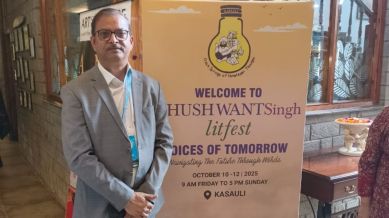Stay updated with the latest - Click here to follow us on Instagram
‘Deras are Dalit Punjab’s search for dignity, not crisis’: Sociologist Santosh K Singh
With over 9,000 deras across 12,000 villages, sociologist says Punjab’s faith spaces reflect plural resilience and caste assertion, not decay

Punjab’s 12,000 villages are home to nearly 9,000 deras, informal spiritual congregations, that, according to sociologist Santosh K Singh, mirror the state’s deep pluralism and the assertion of its marginalised communities rather than religious or social breakdown.
At the session “Dera and the Next Generation: Navigating Punjab’s Crisis” at the Khushwant Singh Literature Festival in Kasauli, Singh discussed his recent book The Deras in conversation with Manraj Grewal Sharma, Resident Editor of The Indian Express at Chandigarh. He argued that Punjab doesn’t need to seek new models for renewal — its living traditions already embody resilience and dialogue.
monthly limit of free stories.
with an Express account.
“Punjab engages you with its complexities,” Singh said, recalling how his research began when he noticed women agricultural labourers in Patiala wearing identical lockets tied to a local dera. “Over time, I realised that deras are not just political institutions, as many scholars tend to frame them, but deeply cultural and social spaces.”
Singh said the widespread presence of deras underscores Punjab’s diversity and challenges the idea of a monolithic religious identity. “The obsession with the monolith has done disservice to our understanding of Punjab. There could be no better example than Punjab society to talk about diversity and its multi-layered religious reality,” he said.
While deras often draw attention for controversies around sect leaders, Singh’s research focuses on smaller, lesser-known spaces such as Dera Sach Khand Ballan in Jalandhar, which rarely make headlines. “Most deras have been broad-brushed under the image of one entrepreneurial Baba. That’s not only unfair but factually wrong,” he said.
Sharma noted how deras have often filled social and spiritual voids, drawing followers from marginalised groups. Singh agreed, stressing the role of caste in shaping Punjab’s religious landscape. “Many deras attract Dalit communities, Ravidasias, Balmikis, Dharmis, who seek dignity and belonging denied to them by the mainstream,” he said. “Dr B R Ambedkar is a central figure in most deras. His writings and portraits are prominently displayed , these spaces are not just about faith, but also about assertion.”
With Scheduled Castes making up over 32 per cent of Punjab’s population, the highest in India, caste remains inseparable from its politics and religion. Yet Singh cautioned against viewing Dalit deras as a single movement. “They are not homogenous. Dalits in Punjab are fragmented across subgroups and are not politically united. That’s why, despite their numbers, representation remains limited,” he said, referring to former chief minister Charanjit Singh Channi’s brief tenure.
When Rahul Singh, the veteran journalist behind this festival, asked whether deras reflect the failure of organised religion, Singh disagreed. “I don’t see deras as a failure of religion. These are spaces for counter-questions , for communities seeking meaning and respect. A society that nurtures such questions is a secure and confident one.”
Concluding the session, Singh said Punjab must trust its own plural legacy. “Punjab doesn’t need to look for a model elsewhere. This land of gurus has always been about inclusion and dialogue. Crisis begins only when we fall into the trap of the monolith. Let diversity be our strength.”